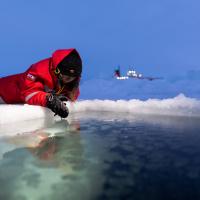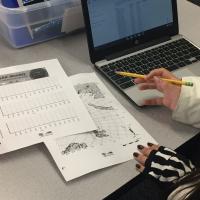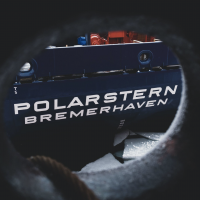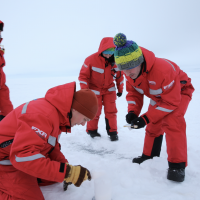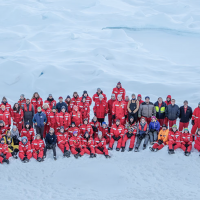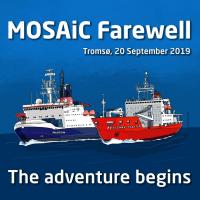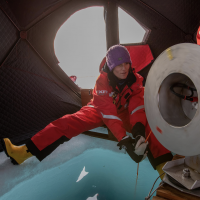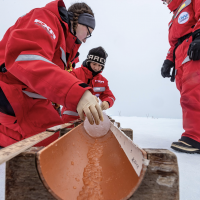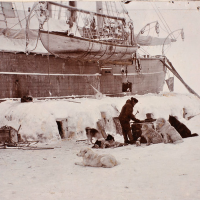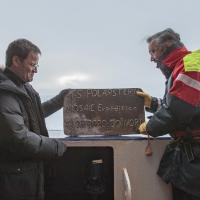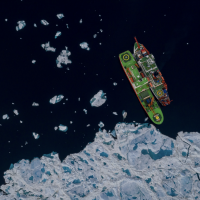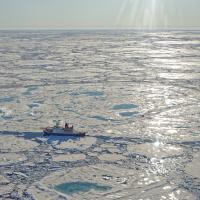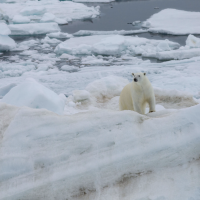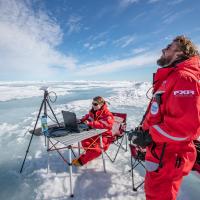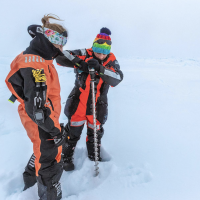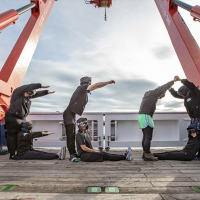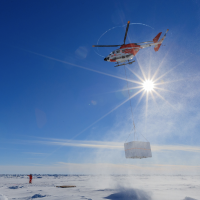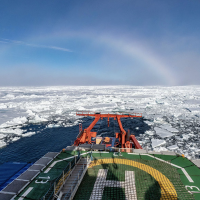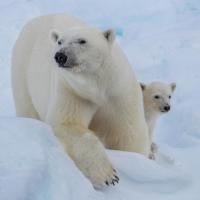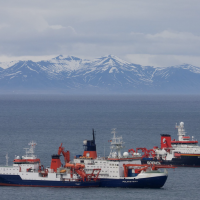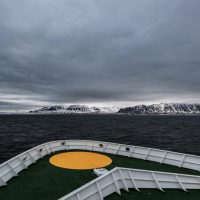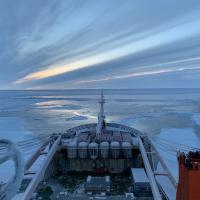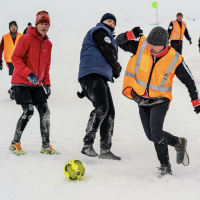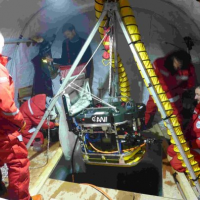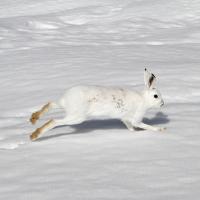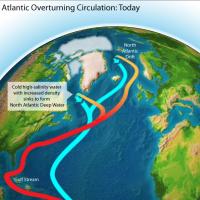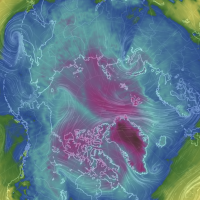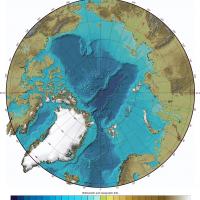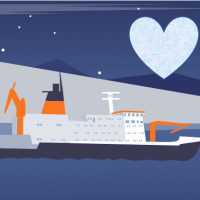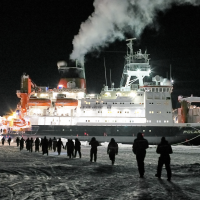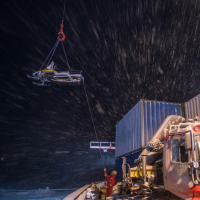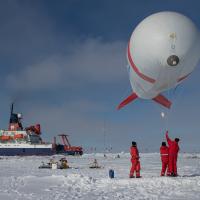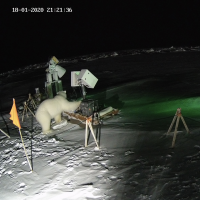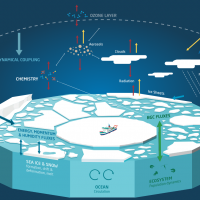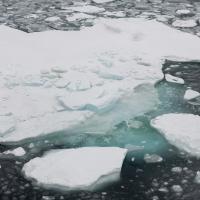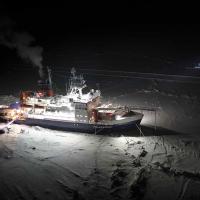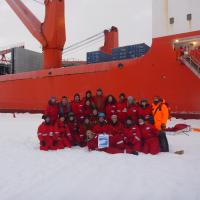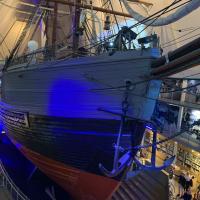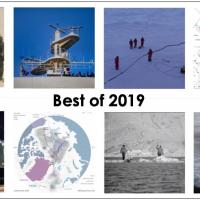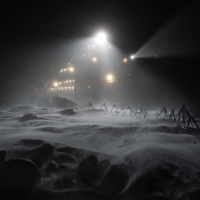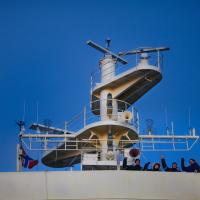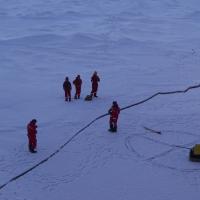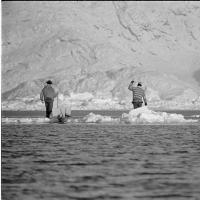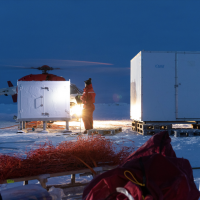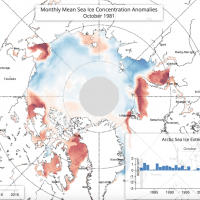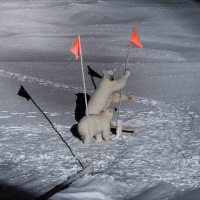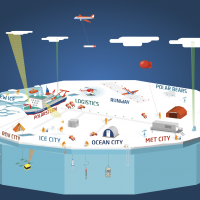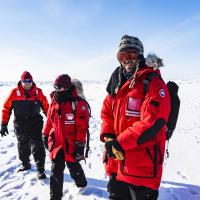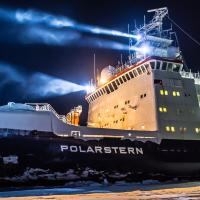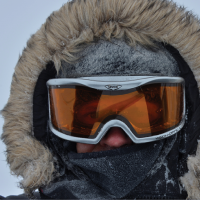A Note to Our MOSAiC Monday Followers
Thank you for following MOSAiC Monday during the 2019-2020 MOSAiC expedition! Starting in November 2020, we'll be transitioning from the weekly MOSAiC Monday publication and newsletter to a monthly newsletter (MOSAiC Monthly). Although the field portion of the MOSAiC expedition has come to an end, there is still a lot of work to do, and in many ways things are just getting started. As scientists go back to their offices and labs to begin analyzing the important Arctic climate system data collected during the expedition, we'll continue to develop and share educational resources with you and keep you updated on the scientists' progress. All you need to do is stay subscribed to the MOSAiC Monday newsletter, and we'll take care of the rest!
We Want Your Feedback
The MOSAiC Monday production team would like your feedback on how you've engaged with MOSAiC Monday and MOSAiC educational materials over the past year. Your feedback is instrumental in helping the CIRES education & outreach team develop the best free, high quality, and relevant educational resources for students and educators that we can, and for securing funding to do so.
Share your MOSAiC Monday feedback by filling out this short survey
MOSAiC Mondays
This week is the final MOSAiC Monday! Stay subscribed to the MM newsletter to keep up to date on new MOSAiC educational resources and more. In this MOSAiC Monday, learn how you can continue learning about the Arctic and polar regions. Photo credit: Stefan Hendricks/AWI
This week: The journey lives on! Educators: We'll continue to create new educational resources using MOSAiC data that you can use to teach about Earth's climate system in your classroom. Also: Scientists, learn how you can participate in the 'Breaking the Ice Ceiling' polar women researchers series!
This week: The Polarstern returns home! And: Monday October 12th is Indigenous Peoples Day in the U.S. Also, check out the engagements with MOSAiC team members that will be going on through November. And just because MOSAiC fieldwork is ending, doesn't mean it is over - learn what's next! Photo credit: Jan Rohde, AWI
This week: Tune in to a live video call with MOSAiC logistics expert and polar bear guard Laura Schmidt on October 5th at 10am ET! Also, send us your welcome home messages for MOSAiC participants. And: Learn about the life cycle of sea ice. Photo credit: Folke Mehrtens, AWI
This week: The Polarstern is on its way back home. Also: How exactly do we define the Arctic? And: Check out this week's featured media resources, including 360-degree videos, podcasts, and more! Photo credit: Lianna Nixon, CIRES/CU Boulder
This week: MOSAiC celebrates 1 year in the Arctic! Also: Learn how you can connect with the science being done by MOSAiC and other CIRES scientists. And: Check out some of the data collected during the expedition. Image credit: Thomas Rackow/AWI
This week: Change is in the air on board the Polarstern. Why does the Arctic experience such drastic swings in seasonal daylight hours compared to lower latitudes? And: PolarTREC educator Katie Gavenus shares educational resources for teaching students of all ages about the seasons. Photo credit: Lianna Nixon, CIRES/CU Boulder
This week: MOSAiC scientists are studying Arctic climate. How is this different from weather? Also: Check out our *new* 360-degree video from the MOSAiC ice floe. And: From the Science at Home Webinar Series to Reach the World, there are so many opportunities to bring scientists into your virtual classroom this fall! Photo credit: Lianna Nixon, CIRES/CU Boulder
This week: Educators, join us on Wednesdays for a new MOSAiC webinar series! Also, the Fram expedition 126 years ago was experiencing a much different Arctic. And: What are the MOSAiC science focus areas, and how are they connected? Photo credit: National Library of Norway
This week: Educators, it isn't too late to incorporate MOSAiC into your classroom! We'll give you tips and resources for how to do this easily and effortlessly. Also: Last week the Polarstern sailed to the top of the world! And: Check out a newly released MOSAiC planetarium show that you can watch right in your web browser. Photo credit: Lianna Nixon, CIRES/CU Boulder
This week: With the leg 4-5 transition complete, MOSAiC enters its final stretch. Also: This is the last week of the MOSAiC Virtual Summer Camp, and we challenge you to rise to epic proportions. Finally: Educators, sign up for a FREE virtual storytelling workshop and learn strategies for connecting and developing relationships with your students virtually. Photo credit: Steffen Graupner/AWI
This week: It is a time of transitions in the Arctic. As the MOSAiC ice floe breaks up, sea ice extent in the Arctic is experiencing a record low. Also, MOSAiC leg 4 participants have seen a plethora of polar bears! And, this week's MOSAiC Summer Camp activity: Can you camo? Photo credit: Steffen Graupner/AWI
This week: The MOSAiC ice floe is approaching the end of its life cycle. Also, check out some of our favorite new MOSAiC multimedia releases. And, this week's MOSAiC Virtual Summer Camp activity: Make your own barometer! Photo credit: Markus Rex, AWI
This week: The Polarstern gets another polar bear visitor! And, you want to know: What are the hottest and coldest months in the Arctic? Photo credit: Lisa Grosfeld
This week: Matthew Shupe, CIRES/NOAA scientist and MOSAiC expedition co-coordinator, gives insight into what is going on in the Arctic. Also, send us your #askmosaic questions. And, this week's MOSAiC Virtual Summer Camp activity: Create a MOSAiC expedition diorama! Photo credit: Lianna Nixon, CIRES
This week: Scientists have discovered the birthplace of the MOSAiC ice flow! Also: Celebrate Arctic Sea Ice Day with Polar Bears International on July 15th. And, this week's MOSAiC Virtual Science Camp activity: Design your own sea ice cooler. Photo credit: Lianna Nixon, CIRES
This week: What are the MOSAiC science teams studying during the central Arctic summer? Also, MOSAiC participants tell us just how 'fancy' the ship is. Finally: This week's Virtual Summer Camp activity will have you shooting for the stars. Photo credit: Lianna Nixon, CIRES
This week: With the research camp infrastructure in place, MOSAiC teams are busy transporting their instruments and equipment back onto the ice. Also, can you make ice cream in the Arctic? How about in a Ziploc bag in your home? Finally: Educators, incorporate more math into your classrooms with MOSAiC Math problems. Photo credit: Lianna Nixon, CIRES
This week: Introducing Educators' Corner and MOSAiC Virtual Summer Camp! Also: The Polarstern is back in its floe, and scientists are preparing to continue their research on, above, and underneath the ice. Photo credit: Lianna Nixon, CIRES
This week: After more than 140 days away form home, leg 3 participants are back on land! Also: learn more about projects and initiatives designed to preserve, compile, and share invaluable indigenous knowledge of the Arctic. Photo credit: Lianna Nixon, CIRES
Happy World Oceans Day/Week! This week: We are committed to amplifying BIPOC voices in science and conservation. Also, check out some of the resources available and live events happening in honor of World Oceans Day. Photo credit: Leonard Magerl
This week: Leg 4 is soon to begin as the Polarstern makes its way south to Svalbard to meet up with two resupply ships. Also, check out a new 360-degree MOSAiC video experience. And: Leg 3 Safety Leader Monica Votvik answers your questions about falling into the frigid Arctic water. Photo credit: Lianna Nixon, CIRES
This week: Sea ice in the Arctic is getting younger. How does 'young' sea ice compare to 'old,' and why is this important? Also, learn how to make your own ice cores with brine channels. Finally, we answer your question about how a volcanic eruption could impact the Arctic and global climate. Photo credit: Esther Horvath/AWI
This week: Learn about the 'life cycles' of sea ice and the different forms it takes on its path to becoming full-fledged sheet ice. Also, how exactly do icebreakers break the ice? Photo credit: Anne Gold, CIRES
This week, learn how the MOSAiC expedition has been weathering the coronavirus pandemic. Also, the Polarstern has drifted farther than expected - will it melt out of the sea ice early? And finally, registration is now open for virtual MOSAiC expedition workshops for teachers this summer! Photo credit: Christian Rohleder
This week: The Central Arctic may look barren, but there is life - polar bears, seals, Arctic foxes. What forms the base of food webs in the Central Arctic? The answer lies beneath the ice... Photo credit: Eric Brossier, courtesy Wageningen University & Research
This week, we'll introduce you to Arctic ecosystems and adaptations that Arctic flora and fauna have for living in such an extreme environment. Also, read about one MOSAiC scientist's recent wildlife sighting, and check out our growing list of polar-related remote and virtual learning resources. Photo credit: Bouke ten Cate
This week: Learn about the latest with MOSAiC, piece together a puzzle to discover how scientists measure sea ice thickness, and learn what some students find most exciting about the expedition. Photo credit: Michael Gutsche/AWI
Did you know that ice forming in the Arctic drives the flow of ocean water all around the globe? This week, we'll explore this phenomenon and more. Also, learn what was on one MOSAiC team member's packing list and check out our new remote learning resources. Figure credit: Illustration by jg. Source for Earth's topology: NASA/JPL-Caltech
This week: Did you know the oceans are constantly in motion? Learn how explorers in the late 1800s discovered one of the most important currents in the Arctic, and why that was important for the MOSAiC expedition. Also, check out our latest remote learning resources, including a brand new 360-degree virtual expedition on the ice with MOSAiC. Image credit: Fluid Earth Viewer
Put on your dry suits - this week we're diving into the Arctic Ocean! Also, MOSAiC scientists and crew answer questions about work shifts and how the ship and equipment is powered. Finally, we'll be continuously updating a list of at-home and virtual polar-related learning resources that both kids and adults can engage with. Image credit: IBCAO
Looking for MOSAiC, Arctic, and polar-related educational resources to engage with at home? Check out this week's MOSAiC Monday for links to videos, activities, virtual engagements, and more! Image credit: AWI
This week, we bring you a monthly expedition update. Leg III of MOSAiC has officially begun, and the sun is back! Also, learn what precautionary measures MOSAiC is taking with the coronavirus outbreak, engage your students in some new MOSAiC math problems, and read how one MOSAiC team member feels about being so far away from his family. Photo credit: Michael Gutsche/AWI
This week: The atmosphere, part 3. What are clouds, how do they form, and why are MOSAiC scientists so interested in them in the Arctic? Is there a correlation between cloud cover and things like temperature? Also, we answer your question about the connection between Arctic sea ice and the atmosphere. Image credit: NASA Earth Observatory
This week: The atmosphere, part 2 - What is air pressure, and what does it have to do with weather? Also, MOSAiC team members answer your questions about wifi on the ship and why a buoy is called a buoy. Photo credit: Esther Horvath/AWI
This week: The atmosphere is an important component of Earth's climate system and a key science focus area of the MOSAiC expedition. Learn more about this thin veneer of gases and other things that is crucial to our survival. Also, we answer your questions about what happens when someone on the Polarstern gets sick. Photo credit: AWI
This week: MOSAiC Leg II is coming to an end as the Russian support icebreaker Dranitsyn is making its way to the Polarstern with Leg III participants. Also, a furry midnight visitor was caught on camera, and MOSAiC team members answer three of your questions! Photo credit: AWI
The high albedo of sea ice and low albedo of ocean water can lead to interesting changes in Earth's climate system - this week, learn about the ice-albedo feedback. Also, MOSAiC scientists answer your questions about living in darkness and cracks in the ice. Figure credit: AWI
This week: Learn about an important component of Earth's energy budget with a fancy name: ALBEDO. And, MOSAiC scientist Julienne Stroeve answers your question about how heavy scientific equipment on the ice is. Also, submit your artwork to the new Museum of MOSAiC Art! Photo credit: Esther Horvath/AWI
This week we'll introduce you to Earth's energy budget, an important science focus area of MOSAiC. Also, learn more about why scientists are interested in exploring the Arctic and how "warm" the Arctic gets. Finally, we're excited to announce we're launching the Museum of MOSAiC Art - find out how you can contribute artwork to one of our virtual galleries! Photo credit: Marcel Nicolaus/AWI
This week: MOSAiC builds an airplane runway and battles a furry white menace. Can you figure out how thick sea ice must be to support an airplane landing on it? Also, learn more about MOSAiC's partnership with Reach the World. Photo credit: Michael Gallagher, CIRES/NOAA
In 2019, 20 early career scientists from around the world joined the first six weeks of the MOSAiC expedition on the icebreaker Fedorov. This week, learn more about the MOSAiC School 2019 and the experiences of the participants. Photo courtesy of APECS
This week, learn more about the 1893 Fram expedition to the Arctic by immersing yourself in a 360-degree virtual experience! Photo credit: Anne Gold, CIRES
This week, we bring you our favorite moments from MOSAiC Monday 2019 and preview what's to come in 2020.
This week: Leg II of the MOSAiC expedition begins! Learn what participants have been up to and how they feel being so far from home. Image credit: AWI
The Polarstern is still in complete darkness, but change is slowly coming. This week: What is the winter solstice? Also, how many people are on the ship at a time? Photo credit: AWI
Leg II of the MOSAiC expedition is about to begin! This week, learn about buoys and look at some of the data coming in from MOSAiC buoys that were deployed in the Arctic. Also, MOSAiC scientist Dr. Marcel Nicolaus answers your question about changing sea ice. Photo credit: Michael Gallagher, CIRES/NOAA
Who owns the Arctic? This week, we dive into that very tricky question, and explore why this is becoming more relevant as the seasonal Arctic sea ice shrinks. Image credit: European Parliamentary Research Service
This week we bring you a MOSAiC expedition week 10 update. Learn how the MOSAiC team has had to adapt to changing Arctic conditions and what they do to relax and have fun when they're not hard at work. Photo credit: Katharina Weiss-Tuider
This week, learn more about Arctic indigenous peoples and how their ways of life are being impacted by climate change. Also, fly through the Arctic in an immersive 360-degree video! Photo credit: Museum for Culture and Science
This week, explore why the Arctic experiences such extreme changes in day length throughout the year. And: We want your feedback! Let us know how MOSAiC Monday can best serve you.
This week: Check in with the MOSAiC expedition and learn what scientists have been up to. Also, scientist Emelia Chamberlain answers your question about Arctic wildlife.
This week: How is the climate changing, and what is going on in the Arctic?
This week: What is climate, and how is it different from weather? Also, read about two furry visitors that have been checking out the Polarstern. Photo credit: Esther Horvath/AWI
What will the MOSAiC scientists be studying during the year-long expedition? How exactly do we define the Arctic region? Find out in this week's MOSAiC Monday. Figure credit: AWI
This week: The MOSAiC expedition begins its drift! And: How do you prepare for a year-long Arctic research expedition? Photo credit: JR Ancheta, UAF
This week, learn about the Arctic expedition 125 years ago that inspired MOSAiC: Set sail with Fridtjof Nansen and the Fram!
This week, watch the expedition launch, take a 3D tour of the Polarstern, and submit your questions to MOSAiC scientists. Photo credit: Stefan Hendricks, AWI
This edition of MOSAiC Monday features a Planetarium show trailer, a map where you and your students can track the Polarstern, and more.
